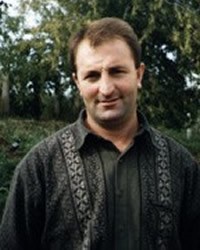Tsakhur in Russia

Photo Source:
Bethany World Prayer Center
|
Send Joshua Project a map of this people group.
|
| People Name: | Tsakhur |
| Country: | Russia |
| 10/40 Window: | No |
| Population: | 13,000 |
| World Population: | 44,000 |
| Primary Language: | Tsakhur |
| Primary Religion: | Islam |
| Christian Adherents: | 0.09 % |
| Evangelicals: | 0.09 % |
| Scripture: | Portions |
| Ministry Resources: | Yes |
| Jesus Film: | No |
| Audio Recordings: | No |
| People Cluster: | Caucasus |
| Affinity Bloc: | Eurasian Peoples |
| Progress Level: |
|
Introduction / History
Roughly two- thirds of all Tsakhur live in northern Azerbaijan. There, they enjoy a mild climate, fertile soil and good communications. The remaining group live in the southwestern part of Russia's Dagestan, a harsh, mountainous area with limited communications. The Tsakhur call themselves Iiqhy but are generally known by the name of their largest village, Tsakhur.
Originally, the Tsakhur lived in Dagestan, but during the thirteenth century, some of them moved north into Azerbaijan. Throughout the years, they have fought for independence from the Turks and Persians. In the beginning of the nineteenth century, they looked to Russia for help and became part of the Russian Empire. In the middle of the nineteenth century, the Tsakhur in Dagestan were exiled to Azerbaijan, but returned to their homeland nine years later. However, others chose to remain in Azerbaijan.
What Are Their Lives Like?
Commonly the Tsakhur are farmers, growing maize, barleycorn, wheat, rice and millet. They also raised cattle, sheep and domestic fowl. Their income was supplemented through gardening, producing silk and growing tobacco.
The Tsakhur diet consists of meat, milk products and grain supplemented by fruits and vegetables. Alcoholic drinks and tea were added in the beginning of the twentieth century. Today, many traditional dishes are still prepared, and techniques for preserving fruits and vegetables and for making jams and pickles have improved.
The Tsakhur traditionally wove textiles from wool combined with silk threads. Other traditional crafts included making rugs, the knitting of woolen socks and footwear, and working in wood, leather and metal. They are also known to be skilled carpenters, stonemasons and tailors.
The Tsakhur formerly belonged to tukhums, or family clusters with common male ancestors. Even though the importance of tukhums is not as great today, Tsakhur people avoid marrying someone from a less prestigious family. Young Tsakhur choose their own marriage partners but still rely on the help of matchmakers. Weddings last two to five days and involve all relatives and villagers. The Tsakhur live in nuclear families, which consist of the father, the mother, and their unmarried children.
In the 1930s, a Latin-based alphabet was introduced to the Tsakhur. However, this script was abandoned some years later, and the Tsakhur language was not used for writing for the remainder of the Soviet period. Azerbaijani has always served as the language of instruction, and today, most Tsakhur are fluent in it. Recently, the decision has been made to make Tsakhur a written language again.
What Are Their Beliefs?
The Tsakhur are almost all Muslim. In the thirteenth century, the city of Tsakhur was one of the main centers of Islam in southern Dagestan. The mosques were the centers of religious life and were erected on the central square of the village. Mullahs (Muslim priests) served in the mosques and carried out various rituals. However, some ceremonies were related to pre-Islamic customs. These included performing the "rites of spring" (lighting bonfires and jumping through them), collecting of flowers, evoking the rain, and performing certain wedding rituals. Traces of animism were also preserved: belief in the special power of stones, trees, fire, water, and spirits. In case of sickness or disease, the Tsakhur traditionally sought the aid of local healers, diviners and sorcerers; used magic; and went on pilgrimages to holy places. Today, modern medicine is used, along with healing arts.
What Are Their Needs?
Over 1,000 years ago many Tsakhur heard the gospel and responded by choosing to follow Christ. However, without a Bible they were unable to pass on their faith to the following generations. The Tsakhur need a viable Christian witness among them. The overwhelming majority have never heard a clear presentation of the gospel.
Prayer Points
Ask the Lord of the harvest to call loving workers to go to the Tsakhur.
Ask the Holy Spirit to soften the hearts of the Tsakhur towards the gospel and the savior.
Ask the Lord to strengthen, protect and embolden the few Tsakhur believers.
Ask God to raise up faithful intercessors who will stand in the gap for the Tsakhur.
Pray that strong local churches will be raised up among the Tsakhur.